Systems Thinking Approaches in Organizations and Projects, PPMP20012
VerifiedAdded on 2023/03/20
|11
|3073
|74
Essay
AI Summary
This essay delves into the application of systems thinking within organizational and project management contexts, emphasizing its importance in addressing complex issues. Drawing upon the Systems Engineering Body of Knowledge (SEBoK) and the AS/NZS 15288 standard, the essay examines the lifecycle management of systems, including engineering risks, organizational structures, and cultural influences. It analyzes leading indicators, such as general systems management and portfolio alignment, and illustrates how these concepts can be applied to real-world scenarios like the Texas City explosion and the Deepwater Horizon oil spill. The essay highlights the significance of risk management tools and organizational maturity, emphasizing the role of systems thinking in preventing disasters and improving overall performance. The analysis incorporates various systems thinking tools and techniques that can aid project managers in problem-solving and strategic implementation, offering a comprehensive understanding of systems thinking's relevance in today's organizations.
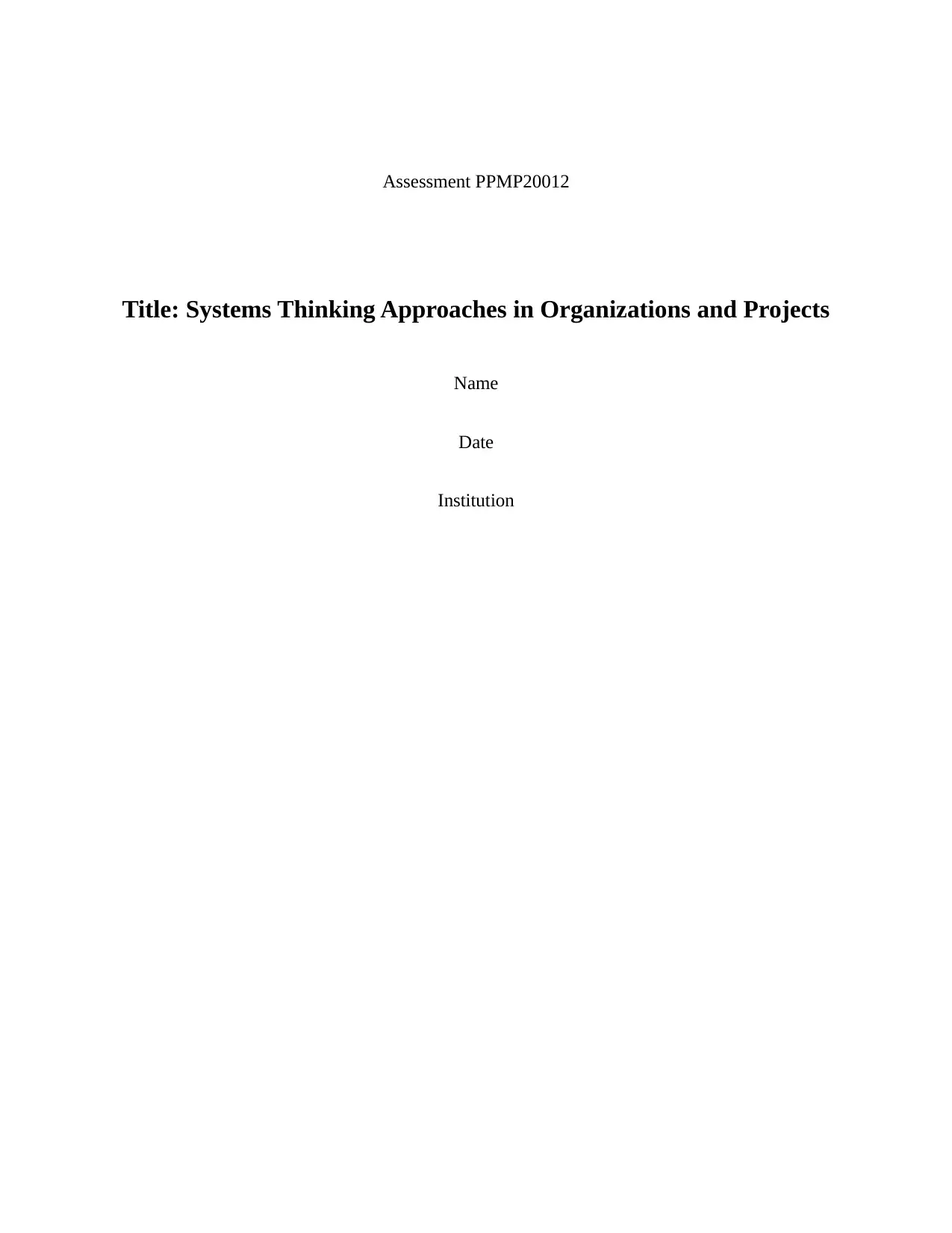
Assessment PPMP20012
Title: Systems Thinking Approaches in Organizations and Projects
Name
Date
Institution
Title: Systems Thinking Approaches in Organizations and Projects
Name
Date
Institution
Paraphrase This Document
Need a fresh take? Get an instant paraphrase of this document with our AI Paraphraser

INTRODUCTION
Systems engineering within the open and closed systems is methodological in design for
technical management of projects and organizations. This approach to solving real issues is
complex because it involves an analysis of general systems and their mechanization. Globally,
the Systems Engineering Body of Knowledge (SEBoK) provides a strategy for effective
engineering systems. This is an organized interdisciplinary approach to problem identification,
design, and support systems for products, services and enterprises. Operating through principles,
models and theories, SEBoK revolves around the life cycle processes and engineering practices.
It combines knowledge, competencies, machines, people, and technology plus management
elements. Therefore a systems thinking approach is a wide concept that requires a breakdown
analysis of different stages using techniques and tools. It puts into consideration the customers,
system users and its stakeholders. A system refers to a large unit made up of basic elements,
units, objects, or variables from different subsystems. A systems approach to organization
involves the interaction of these objects which have different attributes and behaviors. This essay
looks at systems lifecycle management through engineering risks, organizational forms,
structures, culture and the risk management tools. It looks at the environmental influences and
how system contents influence the relevance of such systems in a project or an organization.
ANALYSING LEADING INDICATORS
General Systems Management
Multinational companies suffer the effects of poor systems management caused by failed
systems cycles (Ferreira & Behl, 2014, p. 105). For example, BP experienced a disaster in the
Texas City explosion in which a large industrial explosion killed more than 500 people with
Systems engineering within the open and closed systems is methodological in design for
technical management of projects and organizations. This approach to solving real issues is
complex because it involves an analysis of general systems and their mechanization. Globally,
the Systems Engineering Body of Knowledge (SEBoK) provides a strategy for effective
engineering systems. This is an organized interdisciplinary approach to problem identification,
design, and support systems for products, services and enterprises. Operating through principles,
models and theories, SEBoK revolves around the life cycle processes and engineering practices.
It combines knowledge, competencies, machines, people, and technology plus management
elements. Therefore a systems thinking approach is a wide concept that requires a breakdown
analysis of different stages using techniques and tools. It puts into consideration the customers,
system users and its stakeholders. A system refers to a large unit made up of basic elements,
units, objects, or variables from different subsystems. A systems approach to organization
involves the interaction of these objects which have different attributes and behaviors. This essay
looks at systems lifecycle management through engineering risks, organizational forms,
structures, culture and the risk management tools. It looks at the environmental influences and
how system contents influence the relevance of such systems in a project or an organization.
ANALYSING LEADING INDICATORS
General Systems Management
Multinational companies suffer the effects of poor systems management caused by failed
systems cycles (Ferreira & Behl, 2014, p. 105). For example, BP experienced a disaster in the
Texas City explosion in which a large industrial explosion killed more than 500 people with
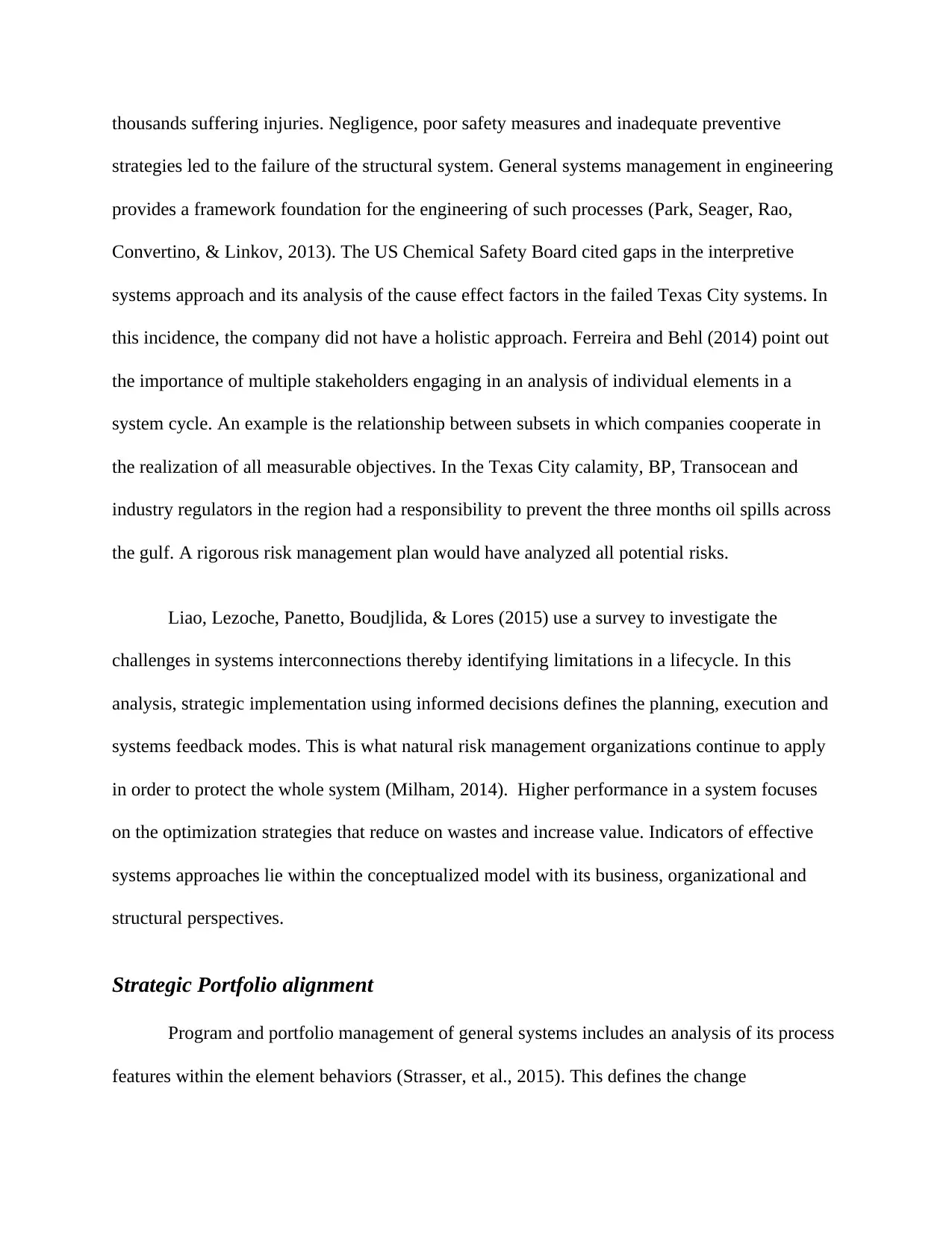
thousands suffering injuries. Negligence, poor safety measures and inadequate preventive
strategies led to the failure of the structural system. General systems management in engineering
provides a framework foundation for the engineering of such processes (Park, Seager, Rao,
Convertino, & Linkov, 2013). The US Chemical Safety Board cited gaps in the interpretive
systems approach and its analysis of the cause effect factors in the failed Texas City systems. In
this incidence, the company did not have a holistic approach. Ferreira and Behl (2014) point out
the importance of multiple stakeholders engaging in an analysis of individual elements in a
system cycle. An example is the relationship between subsets in which companies cooperate in
the realization of all measurable objectives. In the Texas City calamity, BP, Transocean and
industry regulators in the region had a responsibility to prevent the three months oil spills across
the gulf. A rigorous risk management plan would have analyzed all potential risks.
Liao, Lezoche, Panetto, Boudjlida, & Lores (2015) use a survey to investigate the
challenges in systems interconnections thereby identifying limitations in a lifecycle. In this
analysis, strategic implementation using informed decisions defines the planning, execution and
systems feedback modes. This is what natural risk management organizations continue to apply
in order to protect the whole system (Milham, 2014). Higher performance in a system focuses
on the optimization strategies that reduce on wastes and increase value. Indicators of effective
systems approaches lie within the conceptualized model with its business, organizational and
structural perspectives.
Strategic Portfolio alignment
Program and portfolio management of general systems includes an analysis of its process
features within the element behaviors (Strasser, et al., 2015). This defines the change
strategies led to the failure of the structural system. General systems management in engineering
provides a framework foundation for the engineering of such processes (Park, Seager, Rao,
Convertino, & Linkov, 2013). The US Chemical Safety Board cited gaps in the interpretive
systems approach and its analysis of the cause effect factors in the failed Texas City systems. In
this incidence, the company did not have a holistic approach. Ferreira and Behl (2014) point out
the importance of multiple stakeholders engaging in an analysis of individual elements in a
system cycle. An example is the relationship between subsets in which companies cooperate in
the realization of all measurable objectives. In the Texas City calamity, BP, Transocean and
industry regulators in the region had a responsibility to prevent the three months oil spills across
the gulf. A rigorous risk management plan would have analyzed all potential risks.
Liao, Lezoche, Panetto, Boudjlida, & Lores (2015) use a survey to investigate the
challenges in systems interconnections thereby identifying limitations in a lifecycle. In this
analysis, strategic implementation using informed decisions defines the planning, execution and
systems feedback modes. This is what natural risk management organizations continue to apply
in order to protect the whole system (Milham, 2014). Higher performance in a system focuses
on the optimization strategies that reduce on wastes and increase value. Indicators of effective
systems approaches lie within the conceptualized model with its business, organizational and
structural perspectives.
Strategic Portfolio alignment
Program and portfolio management of general systems includes an analysis of its process
features within the element behaviors (Strasser, et al., 2015). This defines the change
⊘ This is a preview!⊘
Do you want full access?
Subscribe today to unlock all pages.

Trusted by 1+ million students worldwide
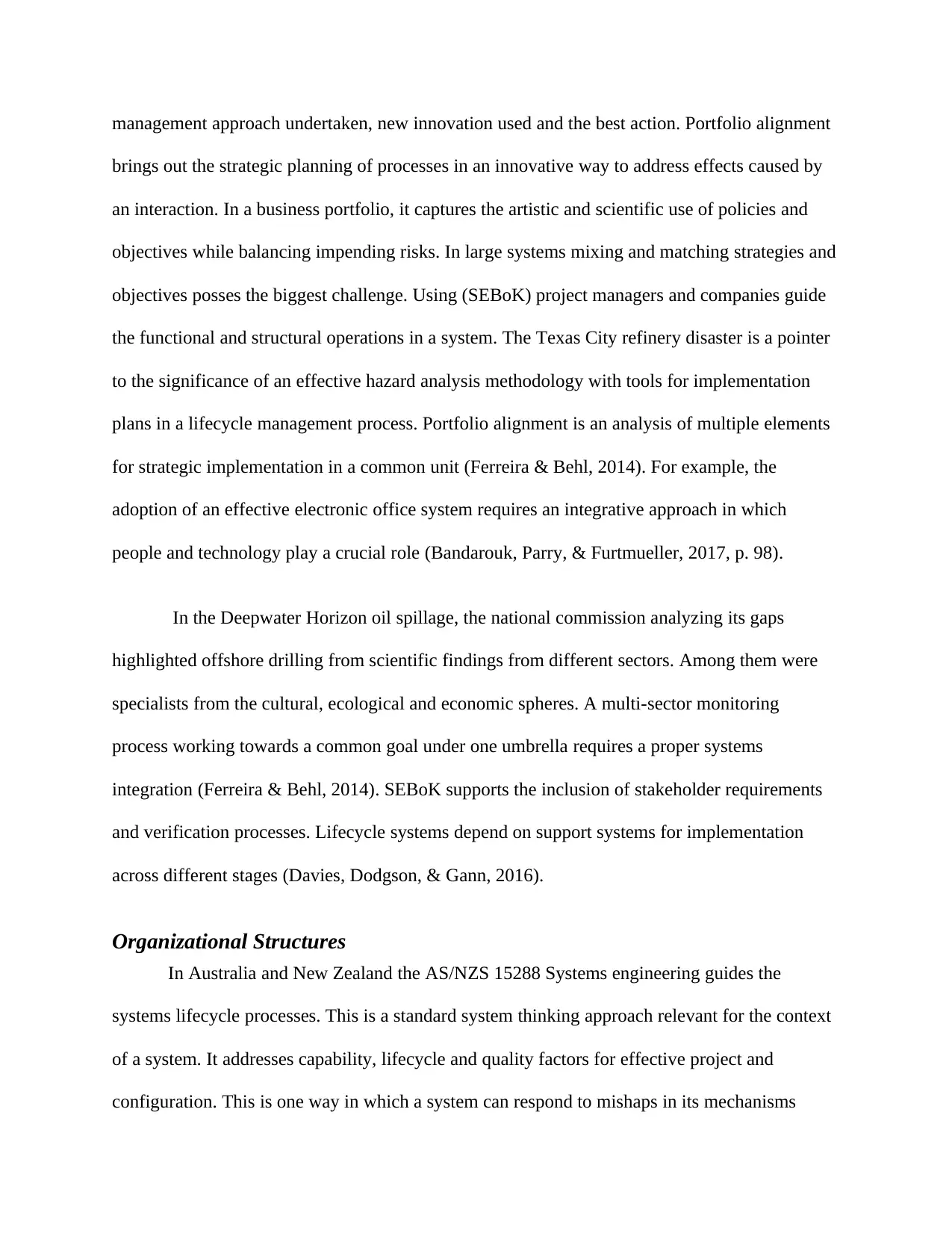
management approach undertaken, new innovation used and the best action. Portfolio alignment
brings out the strategic planning of processes in an innovative way to address effects caused by
an interaction. In a business portfolio, it captures the artistic and scientific use of policies and
objectives while balancing impending risks. In large systems mixing and matching strategies and
objectives posses the biggest challenge. Using (SEBoK) project managers and companies guide
the functional and structural operations in a system. The Texas City refinery disaster is a pointer
to the significance of an effective hazard analysis methodology with tools for implementation
plans in a lifecycle management process. Portfolio alignment is an analysis of multiple elements
for strategic implementation in a common unit (Ferreira & Behl, 2014). For example, the
adoption of an effective electronic office system requires an integrative approach in which
people and technology play a crucial role (Bandarouk, Parry, & Furtmueller, 2017, p. 98).
In the Deepwater Horizon oil spillage, the national commission analyzing its gaps
highlighted offshore drilling from scientific findings from different sectors. Among them were
specialists from the cultural, ecological and economic spheres. A multi-sector monitoring
process working towards a common goal under one umbrella requires a proper systems
integration (Ferreira & Behl, 2014). SEBoK supports the inclusion of stakeholder requirements
and verification processes. Lifecycle systems depend on support systems for implementation
across different stages (Davies, Dodgson, & Gann, 2016).
Organizational Structures
In Australia and New Zealand the AS/NZS 15288 Systems engineering guides the
systems lifecycle processes. This is a standard system thinking approach relevant for the context
of a system. It addresses capability, lifecycle and quality factors for effective project and
configuration. This is one way in which a system can respond to mishaps in its mechanisms
brings out the strategic planning of processes in an innovative way to address effects caused by
an interaction. In a business portfolio, it captures the artistic and scientific use of policies and
objectives while balancing impending risks. In large systems mixing and matching strategies and
objectives posses the biggest challenge. Using (SEBoK) project managers and companies guide
the functional and structural operations in a system. The Texas City refinery disaster is a pointer
to the significance of an effective hazard analysis methodology with tools for implementation
plans in a lifecycle management process. Portfolio alignment is an analysis of multiple elements
for strategic implementation in a common unit (Ferreira & Behl, 2014). For example, the
adoption of an effective electronic office system requires an integrative approach in which
people and technology play a crucial role (Bandarouk, Parry, & Furtmueller, 2017, p. 98).
In the Deepwater Horizon oil spillage, the national commission analyzing its gaps
highlighted offshore drilling from scientific findings from different sectors. Among them were
specialists from the cultural, ecological and economic spheres. A multi-sector monitoring
process working towards a common goal under one umbrella requires a proper systems
integration (Ferreira & Behl, 2014). SEBoK supports the inclusion of stakeholder requirements
and verification processes. Lifecycle systems depend on support systems for implementation
across different stages (Davies, Dodgson, & Gann, 2016).
Organizational Structures
In Australia and New Zealand the AS/NZS 15288 Systems engineering guides the
systems lifecycle processes. This is a standard system thinking approach relevant for the context
of a system. It addresses capability, lifecycle and quality factors for effective project and
configuration. This is one way in which a system can respond to mishaps in its mechanisms
Paraphrase This Document
Need a fresh take? Get an instant paraphrase of this document with our AI Paraphraser
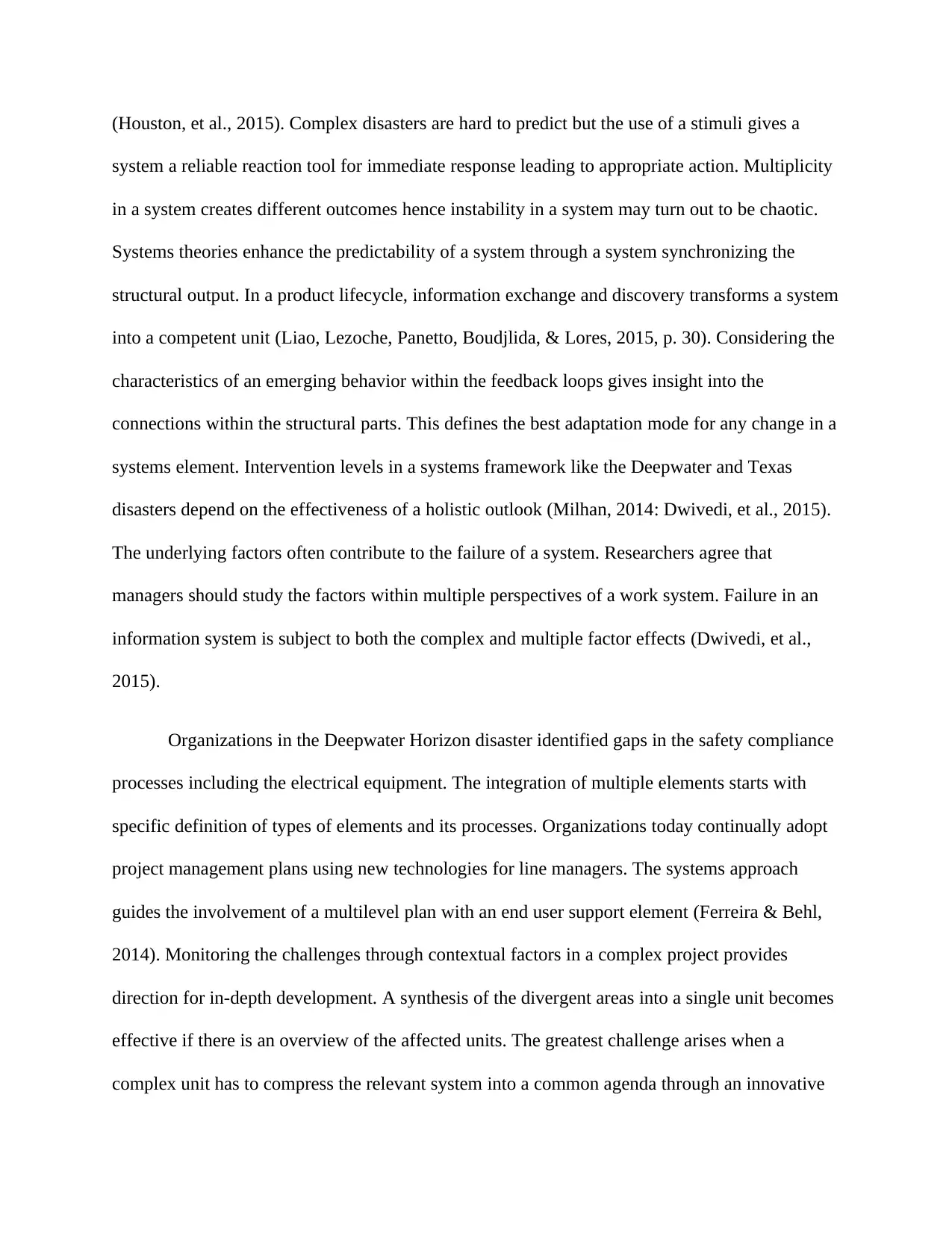
(Houston, et al., 2015). Complex disasters are hard to predict but the use of a stimuli gives a
system a reliable reaction tool for immediate response leading to appropriate action. Multiplicity
in a system creates different outcomes hence instability in a system may turn out to be chaotic.
Systems theories enhance the predictability of a system through a system synchronizing the
structural output. In a product lifecycle, information exchange and discovery transforms a system
into a competent unit (Liao, Lezoche, Panetto, Boudjlida, & Lores, 2015, p. 30). Considering the
characteristics of an emerging behavior within the feedback loops gives insight into the
connections within the structural parts. This defines the best adaptation mode for any change in a
systems element. Intervention levels in a systems framework like the Deepwater and Texas
disasters depend on the effectiveness of a holistic outlook (Milhan, 2014: Dwivedi, et al., 2015).
The underlying factors often contribute to the failure of a system. Researchers agree that
managers should study the factors within multiple perspectives of a work system. Failure in an
information system is subject to both the complex and multiple factor effects (Dwivedi, et al.,
2015).
Organizations in the Deepwater Horizon disaster identified gaps in the safety compliance
processes including the electrical equipment. The integration of multiple elements starts with
specific definition of types of elements and its processes. Organizations today continually adopt
project management plans using new technologies for line managers. The systems approach
guides the involvement of a multilevel plan with an end user support element (Ferreira & Behl,
2014). Monitoring the challenges through contextual factors in a complex project provides
direction for in-depth development. A synthesis of the divergent areas into a single unit becomes
effective if there is an overview of the affected units. The greatest challenge arises when a
complex unit has to compress the relevant system into a common agenda through an innovative
system a reliable reaction tool for immediate response leading to appropriate action. Multiplicity
in a system creates different outcomes hence instability in a system may turn out to be chaotic.
Systems theories enhance the predictability of a system through a system synchronizing the
structural output. In a product lifecycle, information exchange and discovery transforms a system
into a competent unit (Liao, Lezoche, Panetto, Boudjlida, & Lores, 2015, p. 30). Considering the
characteristics of an emerging behavior within the feedback loops gives insight into the
connections within the structural parts. This defines the best adaptation mode for any change in a
systems element. Intervention levels in a systems framework like the Deepwater and Texas
disasters depend on the effectiveness of a holistic outlook (Milhan, 2014: Dwivedi, et al., 2015).
The underlying factors often contribute to the failure of a system. Researchers agree that
managers should study the factors within multiple perspectives of a work system. Failure in an
information system is subject to both the complex and multiple factor effects (Dwivedi, et al.,
2015).
Organizations in the Deepwater Horizon disaster identified gaps in the safety compliance
processes including the electrical equipment. The integration of multiple elements starts with
specific definition of types of elements and its processes. Organizations today continually adopt
project management plans using new technologies for line managers. The systems approach
guides the involvement of a multilevel plan with an end user support element (Ferreira & Behl,
2014). Monitoring the challenges through contextual factors in a complex project provides
direction for in-depth development. A synthesis of the divergent areas into a single unit becomes
effective if there is an overview of the affected units. The greatest challenge arises when a
complex unit has to compress the relevant system into a common agenda through an innovative
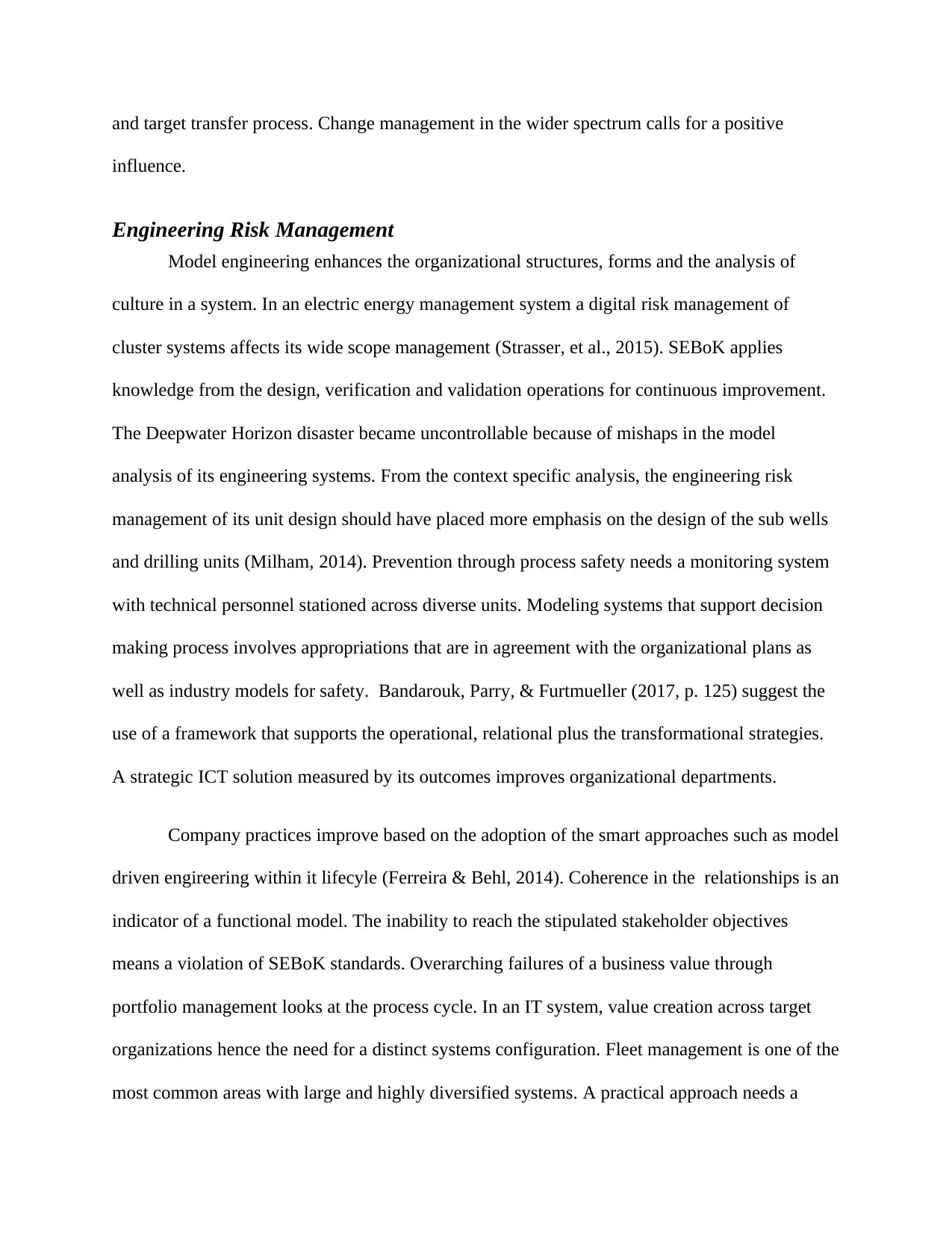
and target transfer process. Change management in the wider spectrum calls for a positive
influence.
Engineering Risk Management
Model engineering enhances the organizational structures, forms and the analysis of
culture in a system. In an electric energy management system a digital risk management of
cluster systems affects its wide scope management (Strasser, et al., 2015). SEBoK applies
knowledge from the design, verification and validation operations for continuous improvement.
The Deepwater Horizon disaster became uncontrollable because of mishaps in the model
analysis of its engineering systems. From the context specific analysis, the engineering risk
management of its unit design should have placed more emphasis on the design of the sub wells
and drilling units (Milham, 2014). Prevention through process safety needs a monitoring system
with technical personnel stationed across diverse units. Modeling systems that support decision
making process involves appropriations that are in agreement with the organizational plans as
well as industry models for safety. Bandarouk, Parry, & Furtmueller (2017, p. 125) suggest the
use of a framework that supports the operational, relational plus the transformational strategies.
A strategic ICT solution measured by its outcomes improves organizational departments.
Company practices improve based on the adoption of the smart approaches such as model
driven engireering within it lifecyle (Ferreira & Behl, 2014). Coherence in the relationships is an
indicator of a functional model. The inability to reach the stipulated stakeholder objectives
means a violation of SEBoK standards. Overarching failures of a business value through
portfolio management looks at the process cycle. In an IT system, value creation across target
organizations hence the need for a distinct systems configuration. Fleet management is one of the
most common areas with large and highly diversified systems. A practical approach needs a
influence.
Engineering Risk Management
Model engineering enhances the organizational structures, forms and the analysis of
culture in a system. In an electric energy management system a digital risk management of
cluster systems affects its wide scope management (Strasser, et al., 2015). SEBoK applies
knowledge from the design, verification and validation operations for continuous improvement.
The Deepwater Horizon disaster became uncontrollable because of mishaps in the model
analysis of its engineering systems. From the context specific analysis, the engineering risk
management of its unit design should have placed more emphasis on the design of the sub wells
and drilling units (Milham, 2014). Prevention through process safety needs a monitoring system
with technical personnel stationed across diverse units. Modeling systems that support decision
making process involves appropriations that are in agreement with the organizational plans as
well as industry models for safety. Bandarouk, Parry, & Furtmueller (2017, p. 125) suggest the
use of a framework that supports the operational, relational plus the transformational strategies.
A strategic ICT solution measured by its outcomes improves organizational departments.
Company practices improve based on the adoption of the smart approaches such as model
driven engireering within it lifecyle (Ferreira & Behl, 2014). Coherence in the relationships is an
indicator of a functional model. The inability to reach the stipulated stakeholder objectives
means a violation of SEBoK standards. Overarching failures of a business value through
portfolio management looks at the process cycle. In an IT system, value creation across target
organizations hence the need for a distinct systems configuration. Fleet management is one of the
most common areas with large and highly diversified systems. A practical approach needs a
⊘ This is a preview!⊘
Do you want full access?
Subscribe today to unlock all pages.

Trusted by 1+ million students worldwide
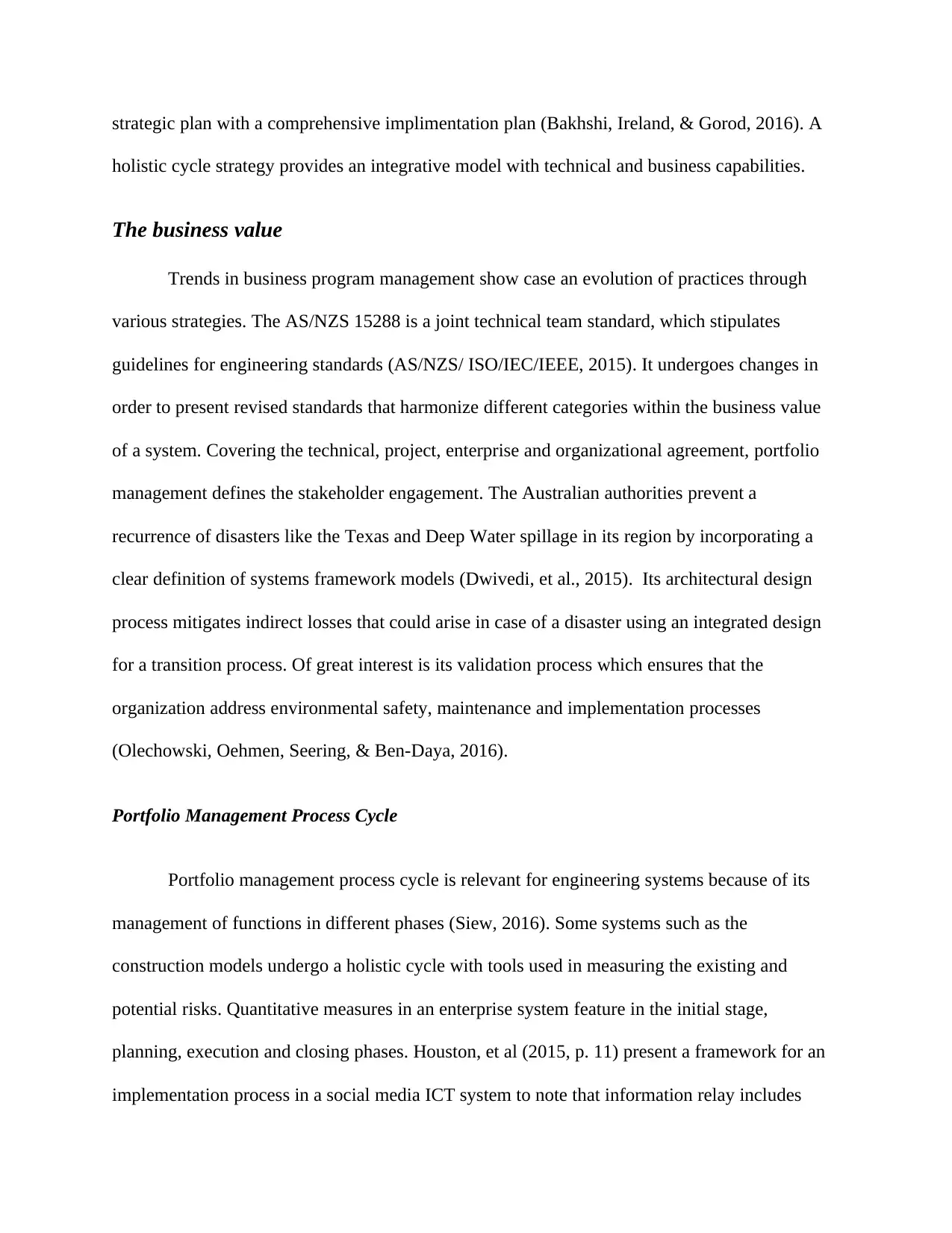
strategic plan with a comprehensive implimentation plan (Bakhshi, Ireland, & Gorod, 2016). A
holistic cycle strategy provides an integrative model with technical and business capabilities.
The business value
Trends in business program management show case an evolution of practices through
various strategies. The AS/NZS 15288 is a joint technical team standard, which stipulates
guidelines for engineering standards (AS/NZS/ ISO/IEC/IEEE, 2015). It undergoes changes in
order to present revised standards that harmonize different categories within the business value
of a system. Covering the technical, project, enterprise and organizational agreement, portfolio
management defines the stakeholder engagement. The Australian authorities prevent a
recurrence of disasters like the Texas and Deep Water spillage in its region by incorporating a
clear definition of systems framework models (Dwivedi, et al., 2015). Its architectural design
process mitigates indirect losses that could arise in case of a disaster using an integrated design
for a transition process. Of great interest is its validation process which ensures that the
organization address environmental safety, maintenance and implementation processes
(Olechowski, Oehmen, Seering, & Ben-Daya, 2016).
Portfolio Management Process Cycle
Portfolio management process cycle is relevant for engineering systems because of its
management of functions in different phases (Siew, 2016). Some systems such as the
construction models undergo a holistic cycle with tools used in measuring the existing and
potential risks. Quantitative measures in an enterprise system feature in the initial stage,
planning, execution and closing phases. Houston, et al (2015, p. 11) present a framework for an
implementation process in a social media ICT system to note that information relay includes
holistic cycle strategy provides an integrative model with technical and business capabilities.
The business value
Trends in business program management show case an evolution of practices through
various strategies. The AS/NZS 15288 is a joint technical team standard, which stipulates
guidelines for engineering standards (AS/NZS/ ISO/IEC/IEEE, 2015). It undergoes changes in
order to present revised standards that harmonize different categories within the business value
of a system. Covering the technical, project, enterprise and organizational agreement, portfolio
management defines the stakeholder engagement. The Australian authorities prevent a
recurrence of disasters like the Texas and Deep Water spillage in its region by incorporating a
clear definition of systems framework models (Dwivedi, et al., 2015). Its architectural design
process mitigates indirect losses that could arise in case of a disaster using an integrated design
for a transition process. Of great interest is its validation process which ensures that the
organization address environmental safety, maintenance and implementation processes
(Olechowski, Oehmen, Seering, & Ben-Daya, 2016).
Portfolio Management Process Cycle
Portfolio management process cycle is relevant for engineering systems because of its
management of functions in different phases (Siew, 2016). Some systems such as the
construction models undergo a holistic cycle with tools used in measuring the existing and
potential risks. Quantitative measures in an enterprise system feature in the initial stage,
planning, execution and closing phases. Houston, et al (2015, p. 11) present a framework for an
implementation process in a social media ICT system to note that information relay includes
Paraphrase This Document
Need a fresh take? Get an instant paraphrase of this document with our AI Paraphraser
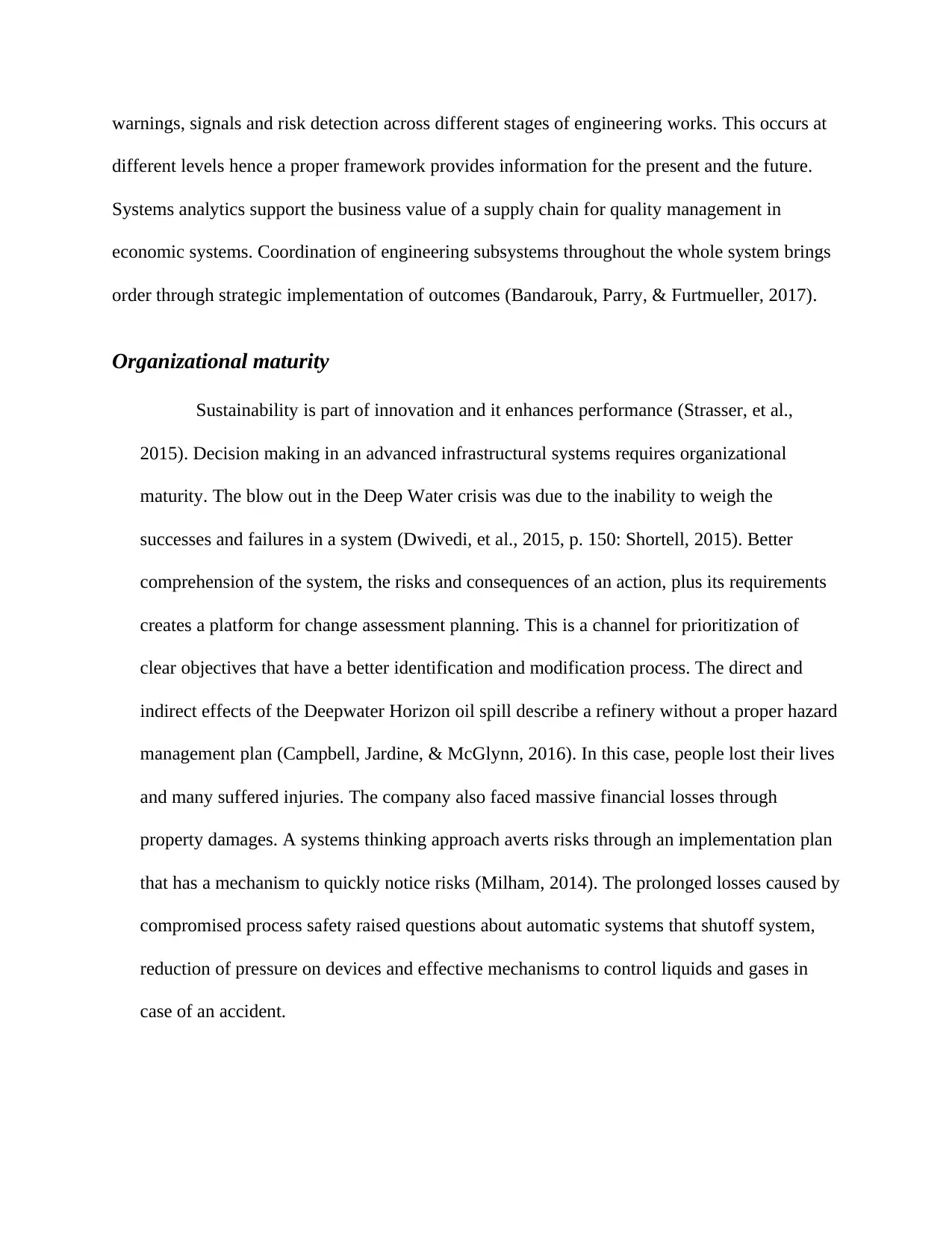
warnings, signals and risk detection across different stages of engineering works. This occurs at
different levels hence a proper framework provides information for the present and the future.
Systems analytics support the business value of a supply chain for quality management in
economic systems. Coordination of engineering subsystems throughout the whole system brings
order through strategic implementation of outcomes (Bandarouk, Parry, & Furtmueller, 2017).
Organizational maturity
Sustainability is part of innovation and it enhances performance (Strasser, et al.,
2015). Decision making in an advanced infrastructural systems requires organizational
maturity. The blow out in the Deep Water crisis was due to the inability to weigh the
successes and failures in a system (Dwivedi, et al., 2015, p. 150: Shortell, 2015). Better
comprehension of the system, the risks and consequences of an action, plus its requirements
creates a platform for change assessment planning. This is a channel for prioritization of
clear objectives that have a better identification and modification process. The direct and
indirect effects of the Deepwater Horizon oil spill describe a refinery without a proper hazard
management plan (Campbell, Jardine, & McGlynn, 2016). In this case, people lost their lives
and many suffered injuries. The company also faced massive financial losses through
property damages. A systems thinking approach averts risks through an implementation plan
that has a mechanism to quickly notice risks (Milham, 2014). The prolonged losses caused by
compromised process safety raised questions about automatic systems that shutoff system,
reduction of pressure on devices and effective mechanisms to control liquids and gases in
case of an accident.
different levels hence a proper framework provides information for the present and the future.
Systems analytics support the business value of a supply chain for quality management in
economic systems. Coordination of engineering subsystems throughout the whole system brings
order through strategic implementation of outcomes (Bandarouk, Parry, & Furtmueller, 2017).
Organizational maturity
Sustainability is part of innovation and it enhances performance (Strasser, et al.,
2015). Decision making in an advanced infrastructural systems requires organizational
maturity. The blow out in the Deep Water crisis was due to the inability to weigh the
successes and failures in a system (Dwivedi, et al., 2015, p. 150: Shortell, 2015). Better
comprehension of the system, the risks and consequences of an action, plus its requirements
creates a platform for change assessment planning. This is a channel for prioritization of
clear objectives that have a better identification and modification process. The direct and
indirect effects of the Deepwater Horizon oil spill describe a refinery without a proper hazard
management plan (Campbell, Jardine, & McGlynn, 2016). In this case, people lost their lives
and many suffered injuries. The company also faced massive financial losses through
property damages. A systems thinking approach averts risks through an implementation plan
that has a mechanism to quickly notice risks (Milham, 2014). The prolonged losses caused by
compromised process safety raised questions about automatic systems that shutoff system,
reduction of pressure on devices and effective mechanisms to control liquids and gases in
case of an accident.
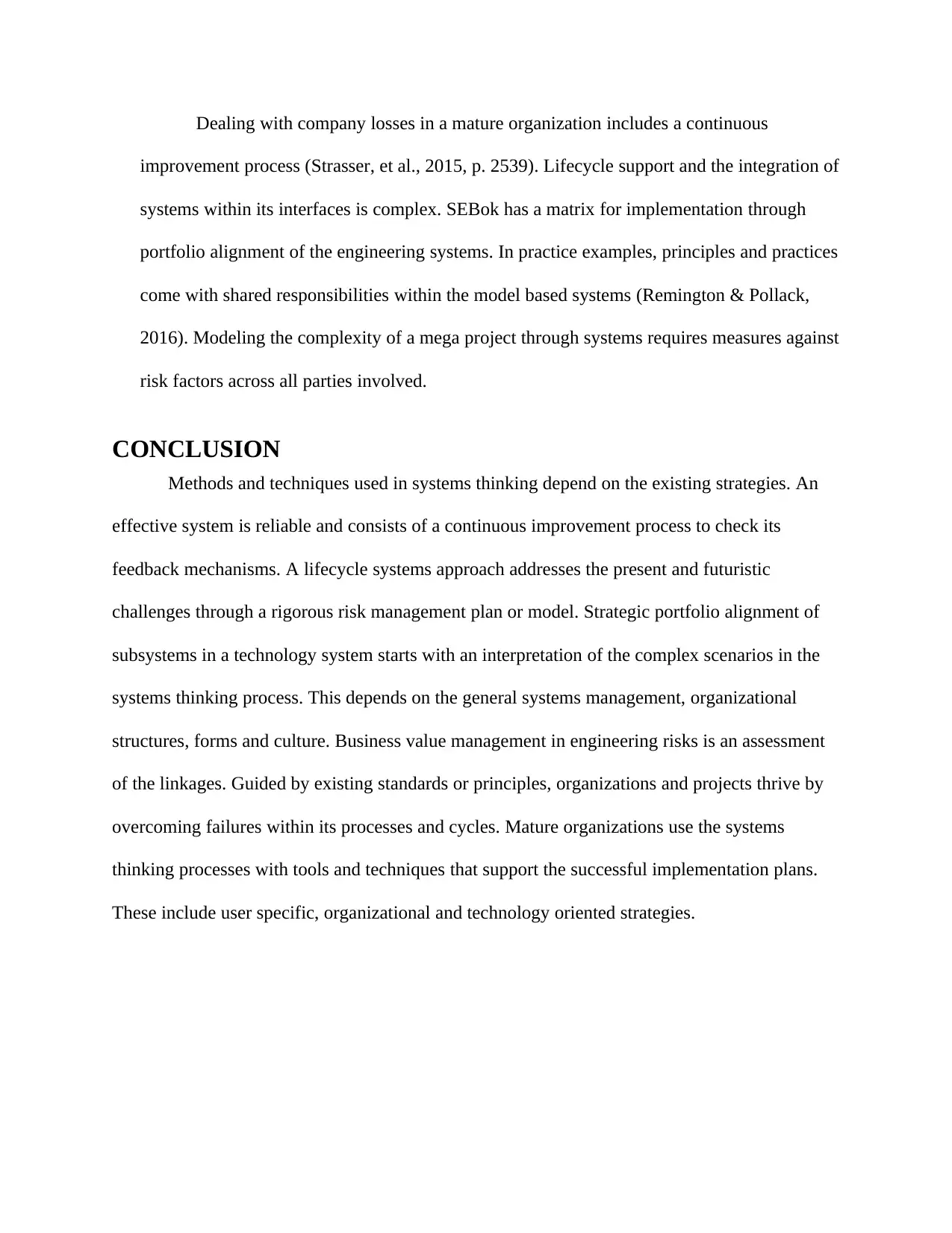
Dealing with company losses in a mature organization includes a continuous
improvement process (Strasser, et al., 2015, p. 2539). Lifecycle support and the integration of
systems within its interfaces is complex. SEBok has a matrix for implementation through
portfolio alignment of the engineering systems. In practice examples, principles and practices
come with shared responsibilities within the model based systems (Remington & Pollack,
2016). Modeling the complexity of a mega project through systems requires measures against
risk factors across all parties involved.
CONCLUSION
Methods and techniques used in systems thinking depend on the existing strategies. An
effective system is reliable and consists of a continuous improvement process to check its
feedback mechanisms. A lifecycle systems approach addresses the present and futuristic
challenges through a rigorous risk management plan or model. Strategic portfolio alignment of
subsystems in a technology system starts with an interpretation of the complex scenarios in the
systems thinking process. This depends on the general systems management, organizational
structures, forms and culture. Business value management in engineering risks is an assessment
of the linkages. Guided by existing standards or principles, organizations and projects thrive by
overcoming failures within its processes and cycles. Mature organizations use the systems
thinking processes with tools and techniques that support the successful implementation plans.
These include user specific, organizational and technology oriented strategies.
improvement process (Strasser, et al., 2015, p. 2539). Lifecycle support and the integration of
systems within its interfaces is complex. SEBok has a matrix for implementation through
portfolio alignment of the engineering systems. In practice examples, principles and practices
come with shared responsibilities within the model based systems (Remington & Pollack,
2016). Modeling the complexity of a mega project through systems requires measures against
risk factors across all parties involved.
CONCLUSION
Methods and techniques used in systems thinking depend on the existing strategies. An
effective system is reliable and consists of a continuous improvement process to check its
feedback mechanisms. A lifecycle systems approach addresses the present and futuristic
challenges through a rigorous risk management plan or model. Strategic portfolio alignment of
subsystems in a technology system starts with an interpretation of the complex scenarios in the
systems thinking process. This depends on the general systems management, organizational
structures, forms and culture. Business value management in engineering risks is an assessment
of the linkages. Guided by existing standards or principles, organizations and projects thrive by
overcoming failures within its processes and cycles. Mature organizations use the systems
thinking processes with tools and techniques that support the successful implementation plans.
These include user specific, organizational and technology oriented strategies.
⊘ This is a preview!⊘
Do you want full access?
Subscribe today to unlock all pages.

Trusted by 1+ million students worldwide
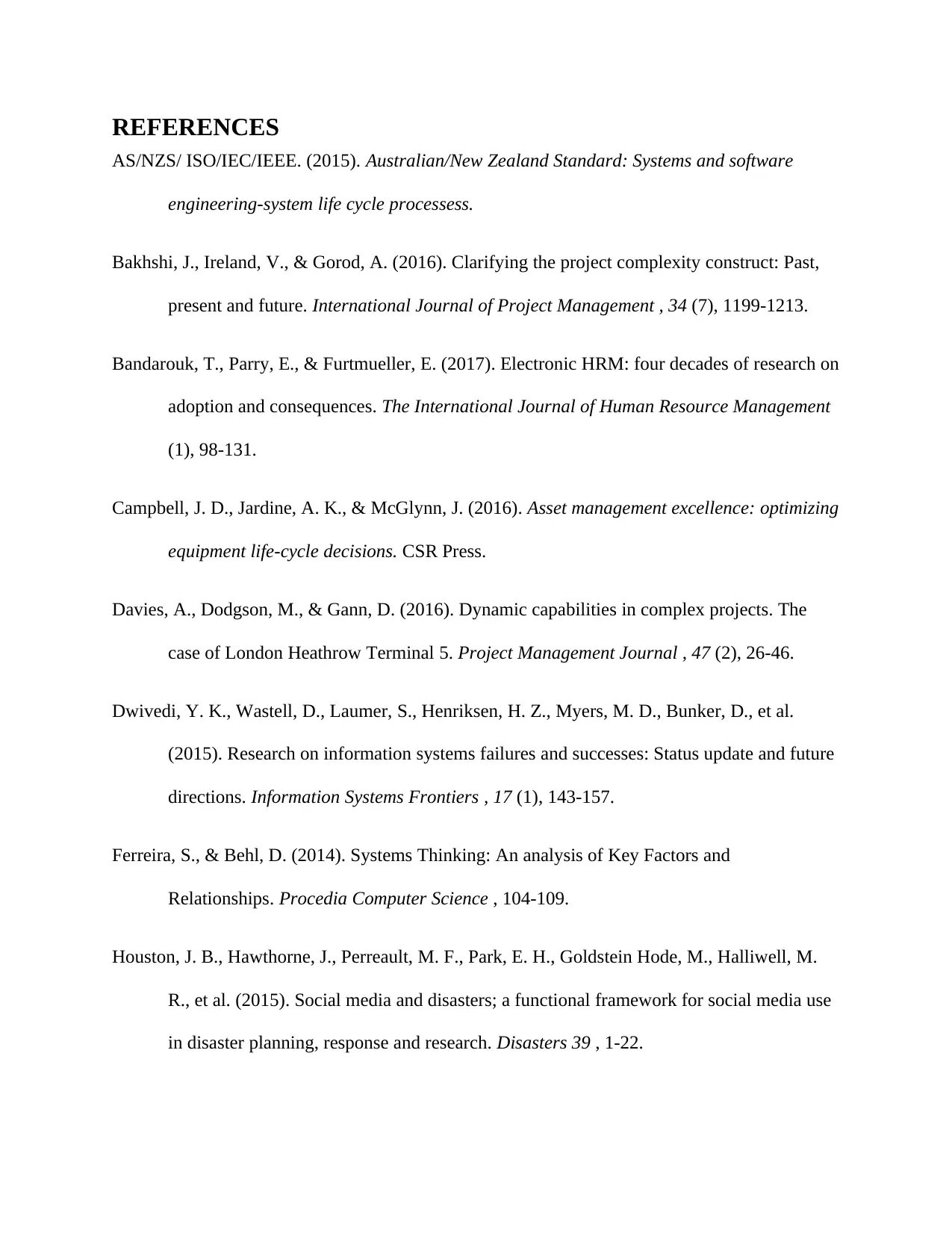
REFERENCES
AS/NZS/ ISO/IEC/IEEE. (2015). Australian/New Zealand Standard: Systems and software
engineering-system life cycle processess.
Bakhshi, J., Ireland, V., & Gorod, A. (2016). Clarifying the project complexity construct: Past,
present and future. International Journal of Project Management , 34 (7), 1199-1213.
Bandarouk, T., Parry, E., & Furtmueller, E. (2017). Electronic HRM: four decades of research on
adoption and consequences. The International Journal of Human Resource Management
(1), 98-131.
Campbell, J. D., Jardine, A. K., & McGlynn, J. (2016). Asset management excellence: optimizing
equipment life-cycle decisions. CSR Press.
Davies, A., Dodgson, M., & Gann, D. (2016). Dynamic capabilities in complex projects. The
case of London Heathrow Terminal 5. Project Management Journal , 47 (2), 26-46.
Dwivedi, Y. K., Wastell, D., Laumer, S., Henriksen, H. Z., Myers, M. D., Bunker, D., et al.
(2015). Research on information systems failures and successes: Status update and future
directions. Information Systems Frontiers , 17 (1), 143-157.
Ferreira, S., & Behl, D. (2014). Systems Thinking: An analysis of Key Factors and
Relationships. Procedia Computer Science , 104-109.
Houston, J. B., Hawthorne, J., Perreault, M. F., Park, E. H., Goldstein Hode, M., Halliwell, M.
R., et al. (2015). Social media and disasters; a functional framework for social media use
in disaster planning, response and research. Disasters 39 , 1-22.
AS/NZS/ ISO/IEC/IEEE. (2015). Australian/New Zealand Standard: Systems and software
engineering-system life cycle processess.
Bakhshi, J., Ireland, V., & Gorod, A. (2016). Clarifying the project complexity construct: Past,
present and future. International Journal of Project Management , 34 (7), 1199-1213.
Bandarouk, T., Parry, E., & Furtmueller, E. (2017). Electronic HRM: four decades of research on
adoption and consequences. The International Journal of Human Resource Management
(1), 98-131.
Campbell, J. D., Jardine, A. K., & McGlynn, J. (2016). Asset management excellence: optimizing
equipment life-cycle decisions. CSR Press.
Davies, A., Dodgson, M., & Gann, D. (2016). Dynamic capabilities in complex projects. The
case of London Heathrow Terminal 5. Project Management Journal , 47 (2), 26-46.
Dwivedi, Y. K., Wastell, D., Laumer, S., Henriksen, H. Z., Myers, M. D., Bunker, D., et al.
(2015). Research on information systems failures and successes: Status update and future
directions. Information Systems Frontiers , 17 (1), 143-157.
Ferreira, S., & Behl, D. (2014). Systems Thinking: An analysis of Key Factors and
Relationships. Procedia Computer Science , 104-109.
Houston, J. B., Hawthorne, J., Perreault, M. F., Park, E. H., Goldstein Hode, M., Halliwell, M.
R., et al. (2015). Social media and disasters; a functional framework for social media use
in disaster planning, response and research. Disasters 39 , 1-22.
Paraphrase This Document
Need a fresh take? Get an instant paraphrase of this document with our AI Paraphraser
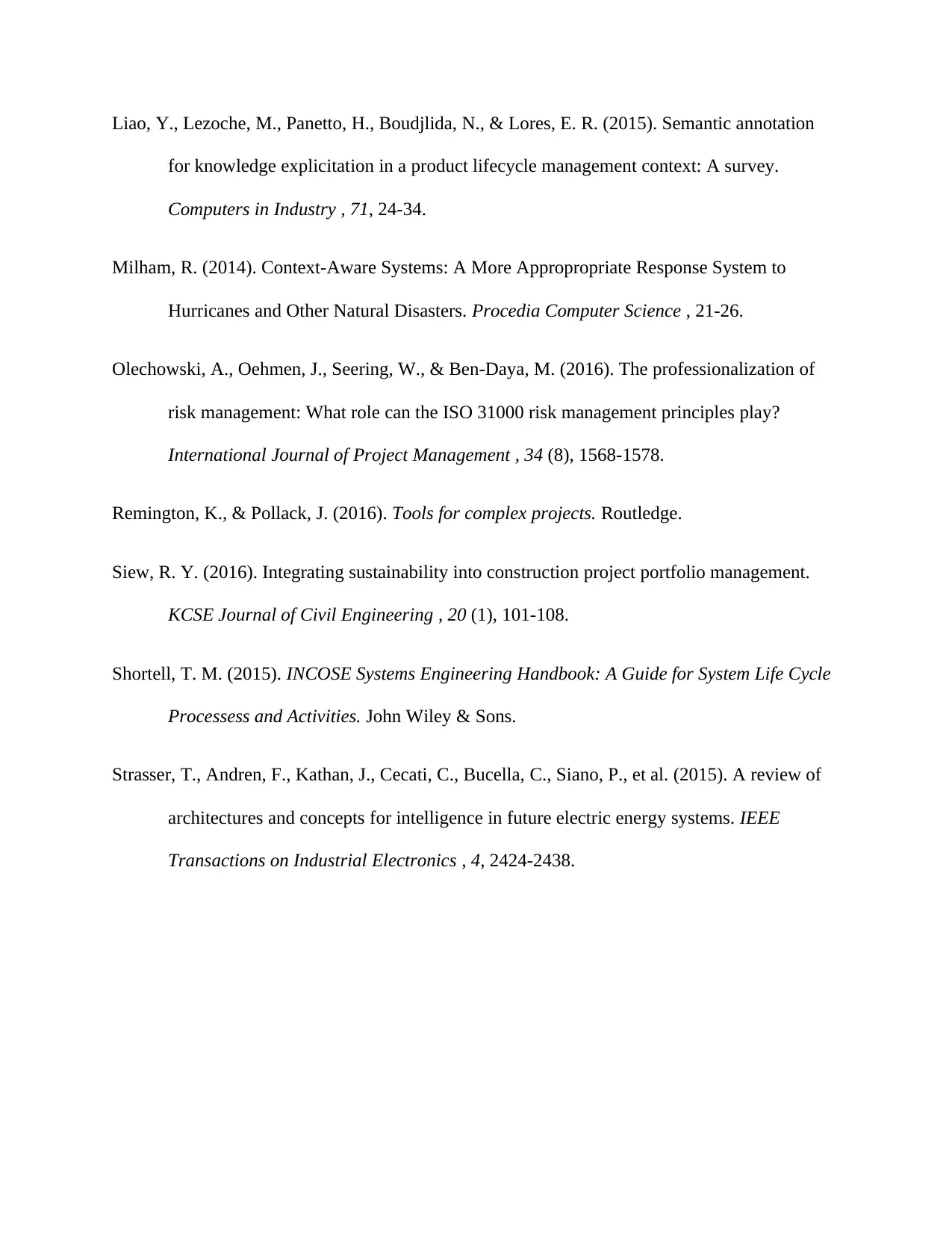
Liao, Y., Lezoche, M., Panetto, H., Boudjlida, N., & Lores, E. R. (2015). Semantic annotation
for knowledge explicitation in a product lifecycle management context: A survey.
Computers in Industry , 71, 24-34.
Milham, R. (2014). Context-Aware Systems: A More Appropropriate Response System to
Hurricanes and Other Natural Disasters. Procedia Computer Science , 21-26.
Olechowski, A., Oehmen, J., Seering, W., & Ben-Daya, M. (2016). The professionalization of
risk management: What role can the ISO 31000 risk management principles play?
International Journal of Project Management , 34 (8), 1568-1578.
Remington, K., & Pollack, J. (2016). Tools for complex projects. Routledge.
Siew, R. Y. (2016). Integrating sustainability into construction project portfolio management.
KCSE Journal of Civil Engineering , 20 (1), 101-108.
Shortell, T. M. (2015). INCOSE Systems Engineering Handbook: A Guide for System Life Cycle
Processess and Activities. John Wiley & Sons.
Strasser, T., Andren, F., Kathan, J., Cecati, C., Bucella, C., Siano, P., et al. (2015). A review of
architectures and concepts for intelligence in future electric energy systems. IEEE
Transactions on Industrial Electronics , 4, 2424-2438.
for knowledge explicitation in a product lifecycle management context: A survey.
Computers in Industry , 71, 24-34.
Milham, R. (2014). Context-Aware Systems: A More Appropropriate Response System to
Hurricanes and Other Natural Disasters. Procedia Computer Science , 21-26.
Olechowski, A., Oehmen, J., Seering, W., & Ben-Daya, M. (2016). The professionalization of
risk management: What role can the ISO 31000 risk management principles play?
International Journal of Project Management , 34 (8), 1568-1578.
Remington, K., & Pollack, J. (2016). Tools for complex projects. Routledge.
Siew, R. Y. (2016). Integrating sustainability into construction project portfolio management.
KCSE Journal of Civil Engineering , 20 (1), 101-108.
Shortell, T. M. (2015). INCOSE Systems Engineering Handbook: A Guide for System Life Cycle
Processess and Activities. John Wiley & Sons.
Strasser, T., Andren, F., Kathan, J., Cecati, C., Bucella, C., Siano, P., et al. (2015). A review of
architectures and concepts for intelligence in future electric energy systems. IEEE
Transactions on Industrial Electronics , 4, 2424-2438.
1 out of 11
Related Documents
Your All-in-One AI-Powered Toolkit for Academic Success.
+13062052269
info@desklib.com
Available 24*7 on WhatsApp / Email
![[object Object]](/_next/static/media/star-bottom.7253800d.svg)
Unlock your academic potential
Copyright © 2020–2025 A2Z Services. All Rights Reserved. Developed and managed by ZUCOL.




